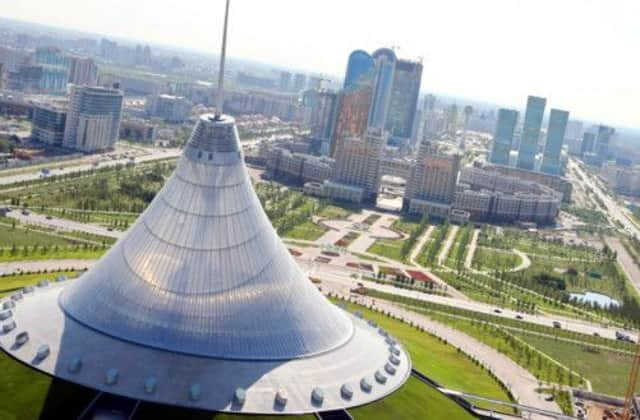Astana: Tradition and opulence side by side


A multi-storey glass pyramid with white doves on the windows promotes peace. A steel tower shaped like an ice cream cone stands in honour of the nation’s president, Nursultan A Nazarbayev, who moved the capital to Astana 16 years ago and spent billions of oil dollars to create an urban showpiece.
The latest addition is an opera house with an opulent interior of beige and red Italian marble, a 3,500lb Bohemian glass chandelier and a lobby about a third the size of a football field.
Advertisement
Hide AdAdvertisement
Hide AdBut beneath the futuristic and expensive designs, ancient traditions of Kazakhstan’s nomadic origins – some say dating from the days of Genghis Khan – are making a comeback on the sports field.
Nostalgia is not limited to sports. Some older residents, who admire the sleek new city, still fondly recall the architecture of the 1950s. Back then, the Soviet leader Nikita Khrushchev transformed the city, then known as Tselinograd, into the headquarters of a campaign to improve the Soviet Union’s grain production.
Recently, on the outskirts of Astana at a stadium slick with rain and mud, the first Central Asian championship of kokpar, an equestrian sport, was in full swing.
Nazarbayev’s capital seemed a world away. Kokpar, known as buzkashi in Afghanistan, is a tough version of polo. Instead of playing from the back of a horse with wooden mallets and a ball, riders use their bare hands and lean to pick up a headless sheep or goat from the ground before racing to the goal. But rather than using goalposts, large cauldrons serve as the goals.
Each team consists of four riders, and the scrum of horses and riders pushing, colliding and surging around the goal with whips cracking creates a rough and violent sport.
“It’s a kind of cruel game playing with a dead sheep, but in our country it’s normal,” said Marat Baytugelov, a retired player, who was watching from the stands as the home team defeated the players from Tajikistan. “The most difficult thing is getting the goal. You have to have strong arms, strong stamina, and you must ride the horse well.”
The animal carcass, he added, cannot be just any weight. Heft is mandatory. It must weigh in at 30 kilograms.
The Central Asian tournament was organised as a prelude to Expo 2017, when Astana will be the host city. Kokpar is expected to be a star attraction, at least for the Central Asian crowd, and even for fans further afield.
Advertisement
Hide AdAdvertisement
Hide AdTo that end, a team from Turkey was invited to participate at the stadium event, and it expects to be back in 2017. The Turkish manager, Sinan Secer, said kokpar had grown in popularity in Turkey, and was played by Turks living in Greece.
The game has yet to make headway in Western Europe, he said, where animal rights activists protest against the use of a dead animal. But whether the animal was real or fake was just a “nuance,” he said. “It doesn’t have to be a dead animal.” Indeed, some consideration is being given to using fake carcasses, he said.
In the centre of Astana, far from the clash of horses, one of the founding architects of the new city, Serik Rustambekov said he took no interest in the centuries-old traditions of kokpar.
But he does harbour affection for the period before the new Astana, and maintains his architecture practice in the old part of the city, known as the Right Bank, which remains free of the expensive new buildings on the Left Bank.
In 1954, when Rustambekov was seven, living with his family in two rooms, when the first settlers from Russia and Ukraine were sent by Khrushchev to grow grain that, according to Moscow’s plans, would allow the Soviet Union’s food supply to catch up with that of the US. At the time, the population of the city was around 100,000, compared with about 700,000 today.
“They brought wagons on sleds pulled by tractors, and then brought in people, some were young people with families,” he said. “Everything was organised and brought from somewhere else. Sometimes they brought in food by plane.”
Low-rise apartment buildings were built out of concrete panels hauled by train from St Petersburg, he said. Those apartments still exist, occupied by families who were already there when Nazarbayev sent civil servants from the old capital, Almaty, to live in new blocks of high rises.
Many of the government workers were reluctant to leave the cosmopolitan atmosphere of Almaty, with its Viennese-style coffee shops, European-style pavements and shade trees. So when Rustambekov worked on the original plans of Astana in the late 1990s, he designed a simple walkway, a cosy retreat that led to the banks of the Ishim River. “You could buy flowers, have coffee and ice cream, rent a bicycle,” he said. “In winter, you could rent skates or cross-country skis.”
Advertisement
Hide AdAdvertisement
Hide AdLike everything else in Astana, the walkway, despite its modest scale, had a grand name: the Millennium Gallery. Nazarbayev, who is said to approve details on every new structure in Astana, opened it. But after five years, Rustambekov said, the simplicity fell out of favour.
“The city administration destroyed it,” he said, “and built a big residential complex instead.”